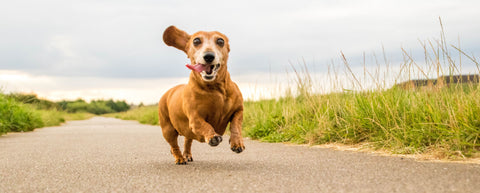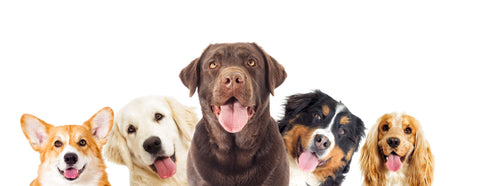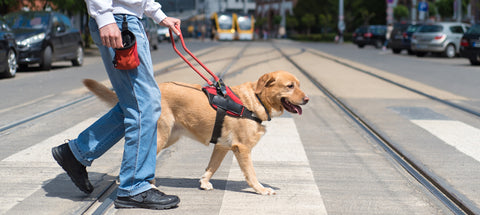If your poor hound is scratching non-stop and leaving a trail of white flakes of skin, chances are, it’s dog dandruff. In this post, we delve into the causes of dog dandruff, when you should take it seriously as an owner, and what the perfect home remedies are…
Do dogs get dandruff?
Yes. Just like their moms and dads, dogs can suffer from dandruff. Due to the sheer amount of hair dogs have, dandruff can be a bigger issue for your four-legged friend than it is for you. In fact, it could even be a sign of a more serious underlying issue.
What does dog dandruff look like?
Well, it looks exactly the same as human dandruff. You’ll probably notice telltale white flakes all over your dog’s coat and latched on to your dog’s fur. These flakes could be all over the house, too!

What kind of dogs get dandruff?
Just like us pet parents, some dogs are more prone to dandruff than others. This is because dogs’ skin naturally produces sebum, an oil that helps to keep it moist and elasticated. Too much or too little of this oil can cause skin conditions. And some breeds of dog naturally have higher or lower levels of sebum, resulting in dog dandruff that’s known as dry or oily.
Breeds susceptible to oily dandruff are:
- Basset Hounds
- Spaniels – like Cocker Spaniels and King Charles Spaniels
- Labrador Retrievers
- Most terrier dog breeds – like West Highland White Terriers, Yorkshire Terriers and Jack Russel Terriers
Breeds susceptible to dry dandruff are:
- German Shepherds
- Doberman Pinschers
- Dachshunds
Just so you know, puppies tend to be affected by dandruff more than adult dogs. This is because their sebum glands are still developing. After about four months, the glands will be more active, and a dandruff issue will likely resolve itself naturally.

What are the causes of dandruff in dogs?
Why does my dog have dandruff? And what are the reasons behind it? Let’s take a closer look at the causes to answer those questions…
- Dry air. Just like us, dogs can be affected by the drier, colder air in late fall and winter. Our air conditioning and HVAC systems can also dry out the air and aggravate the problem.
- Stress. Stress is often the reason behind extra shedding in your canine companion, which in turn causes excessive dandruff. Read our handy guide on how to spot signs of stress in your pet.
- Nutrition. An unbalanced diet can cause your dog to miss out on necessary nutrients for a healthy skin and coat. Fatty acids like Omega 3s and Omega 6’s play an important role in skin health, so it’s important that their diet is full of them!
- Skin infections. Bacterial or fungal infections are one of the main causes of dandruff in dogs. And it doesn’t matter if the dandruff or the infection came first. When in doubt, check it out with a visit to your veterinarian.
- Allergies. Food and environmental allergies in dogs often present themselves as skin problems. In this case, dandruff would usually be just one of many symptoms.
- Lack of grooming. As your dog grows older, he or she may groom themselves less often. This is usually because joint stiffness makes it uncomfortable for your pup to clean themselves. If you’re noticing any signs of stiffness in your pup, why not try our YuMOVE Joint Supplements for Adult Dogs? They’re enriched with a scientifically proven formula that works to soothe joints. Plus, it comes with a NASC stamp of approval.
What is walking dandruff in dogs?
You may well mistakenly diagnose your dog with ‘dandruff’ when it’s actually Cheyletiella mites. Commonly known as walking dandruff, these mites look visually similar to white dandruff flakes. Despite the similar name, walking dandruff is not the same as regular dog dandruff. These unwanted guests feed on your dog’s skin and cause extreme itchiness.
The good news? These pesky parasites are relatively easy to get rid of. The dog-loving mites are vulnerable to most tick, flea and mite products. And – as always – if you have any concerns, please reach out to your vet.

How to treat dog dandruff
Is your dog’s severe dandruff causing a mess around your home? Are they more irritable and itchy because of it? You may well be scouring the web for a natural home remedy, but be careful not to get caught up in all that dodgy doggy advice! How do you get rid of dog dandruff? Well, we’d suggest sidestepping the lime juice, apple cider vinegar and oatmeal concoctions, and following the advice below:
Groom your dog to distribute the oil in their skin
This is the foundation for skin and coat health in dogs. It helps to spread excess skin oil all over the coat, as well as remove dead hair. We recommend following these expert tips to keep your dog’s coat shiny and healthy:
- Brush your dog daily during a dandruff outbreak. In normal times, brush your dog three times a week if they have a long coat. If your pup has short hair, they’ll need to be brushed weekly.
- Buy dog food with a meat source as the main ingredient – such as chicken or lamb. A dog’s coat consists of roughly 90% protein, so a protein-high diet will help to keep them looking shiny.
- Stick to the washing schedule for your dog’s coat type. Frequent bathing can dry out their skin. On the other paw, a good bath is the perfect remedy for calming dandruff outbreaks…
Bath your pup to soothe their skin
Whether your pooch is a natural water-lover or not, keeping them clean is essential for their health. Plus, bathing is one of the best treatments to reduce dandruff outbreaks and soothe any skin infections. Here’s a couple of our top bathing tips for your dog:
- Use dog-specific shampoos. Using ones made for humans can actually make the problem worse.
- Avoid your dog’s head. Start by wetting their body first. Why? When a dog’s head gets wet, they’ll almost immediately shake off all the water!
- Keep the shampoo away from your pup’s mouth and eyes. It’s safer to use a sponge or wash cloth to wipe around these areas.
- Always rinse well. Leaving shampoo on your dog aggravates existing skin conditions.
- Dry your dog immediately after washing them. A damp coat can lead to fungal growth – no fun for anyone!
Keep your hound hydrated
Even a mild case of dehydration can cause flakiness and dry skin in your beloved pooch. To encourage water intake, follow these hydrating hints:
- Ensure your hound’s water bowl is always clean and filled with fresh water.
- Place their water bowl close to their food, or near their favorite spot in the house.
- Add some warm water to your dog’s dry food.
Maintain a cozy temperature in your home
Keeping your dog’s environment at a comfortable temperature is likely to reduce dandruff caused by cold air or warm heaters. We also recommend adding a humidifier to your home to introduce some much-needed moisture into the air. Remember, you’re not a bad pet parent if your dog’s skin is drier in winter. Seasonal dry skin is completely normal!
Feed your dog a nutritional diet
Eating the right foods is so important for healthy canine skin. Make sure that you’re staying on top of your dog’s weight and nutrition habits. This will encourage good fur health and will reduce the frequency of dandruff outbreaks.
Adding Omega 3s to your dog’s diet
The key to a healthy, shiny, glossy coat? The right nutrients – such as Omega 3 fatty acids. Consider a supplement to give your hound that extra boost. Our handy guide to picking the right supplement for your dog will explain all.
When to see the vet
Dandruff on its own isn’t necessarily a cause for concern. A few flakes here and there – especially when it’s cooler and drier outside – aren’t necessarily something to worry about.
But bear in mind that sudden dog dandruff could potentially be the sign of something more serious as we’ve mentioned, like allergies or skin infections. It’s important to consult your veterinarian if your dog is showing any of the following warning signs:
- Extreme itchiness
- Abnormal odor
- Hair loss
- Irritated skin or redness
- Any other signs of doggy discomfort
As a pet parent, you know your dog best! Even if they’re not showing any of the other symptoms listed above, take a visit to the veterinarian if you’re still concerned by their dandruff levels.

Tips to prevent dog dandruff
If your pup is suffering from dandruff as a result of either oily or dry skin, they’re likely to be itchy and incredibly uncomfortable, too. This can result in continuous scratching or chewing. Any measures you take to prevent dog dandruff and to address the underlying condition – if there is one – will be greatly appreciated by your furry best friend.
The best tip for dandruff prevention is to follow a daily doggy care routine, like the one below:
- Brush your dog daily to remove dead hair and skin, and to spread those naturally occurring oils over the coat. Make sure you’re using the right brush for your dog’s hair!
- Check your canine for signs of skin conditions, like allergies or infection, while grooming. If you’re worried about something, always get your pooch checked over by a veterinarian as soon as possible.
- Massage your pooch using a dog-friendly grooming mitt. This helps to distribute body oils and increase blood flow to the skin.
- Apply any veterinarian-advised ointments. If your dog has been prescribed a treatment by your vet, make sure you don’t miss any of their doses.
- Take your dog on a daily walk and provide a good-quality exercise routine and diet.
- Top up your pup’s diet with a health-boosting supplement. Remember, just like prescribed treatments, make sure you keep up with the daily dosage!
The dog dandruff rundown
To recap, dandruff is a dilemma most dog parents will have to face at some point in their lives. But, it doesn’t have to be such a chore to treat. By following our handy hints, you’ll be able to fight the flakes in no time!
And remember, when in doubt, get it checked out. Always seek the advice of your veterinarian if you have any concerns. They’ll be able to advise if there’s something more serious going on beneath the surface.
Have you got any tips to fight the flakes? Slide on over to our Facebook and Instagram pages to share your expertise!










